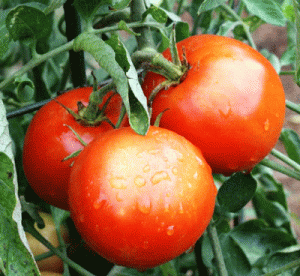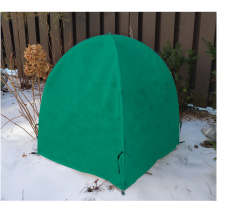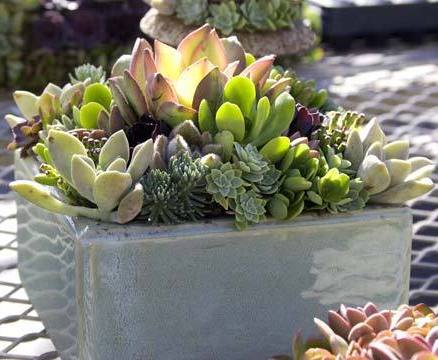 In fear that a late frost would damage young plants, we’ve been holding back our spring stock until now. That’s no longer the case. It’s time to update flowerbeds and containers and time to get after the vegetable garden! This is the week that garden centers are at full plant capacity. You will find a glut of plants overflowing into parking lots and greenhouses, just waiting to be ‘taken home’.
In fear that a late frost would damage young plants, we’ve been holding back our spring stock until now. That’s no longer the case. It’s time to update flowerbeds and containers and time to get after the vegetable garden! This is the week that garden centers are at full plant capacity. You will find a glut of plants overflowing into parking lots and greenhouses, just waiting to be ‘taken home’.
Among the most sought-after plants of the season are tomatoes, the stars of most kitchen gardens. Because tomatoes can be planted now, they have taken over garden centers’ display benches. Whether you are a first-time tomato gardener or had some problems last year, here are some tips for tomato harvest success.
Best Varieties – Choosing climate-appropriate varieties is a must. To guarantee crop success, be sure to select from medium-sized tomatoes like Champion, Celebrity, Early Girl, and Better Boy. Also, any of the smaller varieties like yellow pear, cherry tomatoes, and Sweet 100’s perform exceptionally well in our area. Because of cold night temperatures at this altitude, varieties bearing larger tomatoes tend to struggle, but with a bit more TLC it is possible to grow tomatoes the size of your fist.
Composted Mulch – Tomatoes enjoy a rich garden soil that drains well. Be careful not to add too much manure, which has a high content of nitrogen. Tomato plants in nitrogen-rich soil result in huge vines with little fruit growth. You want to starve tomatoes of nitrogen and give them plenty of phosphorus, the element indicated by the middle of the three numbers shown on a fertilizer bag. Phosphorus helps plants produce more roots and fruits, which is exactly what we want for productive tomato plants.
Nutrition Supplements – Along with compost and mulch consider turning into the soil some bone meal, 0-10-0, or super phosphate, 0-18-0. These additives encourage larger, better tasting fruits. Gypsum is also recommended to produce superior tomatoes. Gypsum is made of calcium sulfate, which reduces blossom end rot and fruits that split open. Sprinkle a little gypsum in the bottom of the planting hole, cover it with just a little dirt, then top dress with a “Tomato & Vegetable Food”.
Plant Deep – Always plant a tomato as deeply as possible. Tomatoes are one of the few plants that will root from the hairs on the vine. Prune off the side shoots and leaves from the bottom of the plant, 2-6 inches above the root ball. Then plant the vine as deeply as possible, but don’t bury the attached leaves. Roots will begin to grow quickly from up and down the buried stem. This will develop a larger, deeper root structure, which is exactly what a tomato plant needs to contend with the arid months of May and June.
Warm the Soil – Right now soils can be cool for these first summer vegetable plants. To plant tomatoes now, we must warm the soil quickly and protect the plants by surrounding them with an ‘Early Season Plant Protector’. The water-filled tubes of these protective structures surround new plants and form mini greenhouses promoting deeper, stronger root formations for this early planting. They really work.  Truly, in the past I’ve had snow hit my garden, and plants surrounded by these protective barriers have kept on fruiting!
Truly, in the past I’ve had snow hit my garden, and plants surrounded by these protective barriers have kept on fruiting!
Another quick and easy plant protector is the ‘Nuvue Frost Cover’. These spring-loaded mini pop-up greenhouses are made of green frost blanket. Plant the garden and then cover it with these protectors against cool temperatures and early spring bugs.
Either the ‘Early Season Plant Protectors’ or the ‘Nuvue Frost Covers’ are worthwhile investments, as they are reusable for years. Either of these products will enable you to plant your tomatoes now and expect your harvest a full month ahead of the neighbors’!
~~ ~~ ~~ ~~ ~~ ~~ ~~

Plant of the Week – Unrelated to tomatoes, this week’s photo is a decorative bowl of succulents grown with Mother’s Day gifting in mind. The leaves of these somewhat exotic-looking plants grow in an amazing array of colors ranging from pale blues and greens to deep oranges and reds. Most have a cactus-like bloom in vivid florescent colors.
Succulents come in both long-living perennials, like ‘Chicks-and-hens’ that are well known for their durability and easy care, as well as annual “showboating” varieties. Selecting from both varieties offers a long list of choices. The perennial varieties enjoy a winter hardiness that no cactus ever could muster; many can tolerate temperatures well below zero and remain evergreen throughout winter. Succulents are excellent rock garden plants in places where neglect, summer heat, wind, and winter cold are commonplace. They are easy plants to use in those all-too-familiar and deadly hot spots of our yards. An ideal gift for garden enthusiasts, I also find that a container of these unusual plants makes an excellent conversation starter at backyard gatherings.
Until next week, I’ll see you in the garden center.

